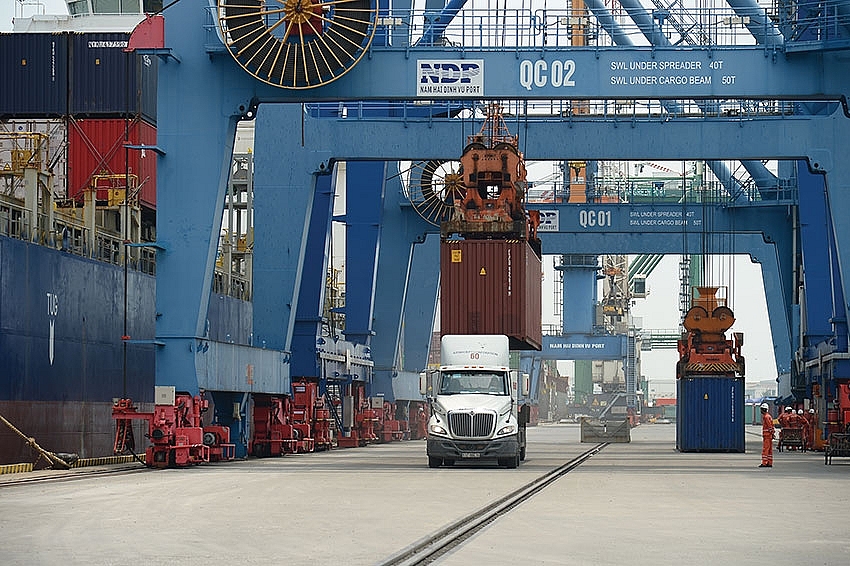Improving international integration through FTAs
 |
| Agreements such as the CPTPP and EVTFTA help shield countries like Vietnam from global economic uncertainties, Photo: Dung Minh |
Over past decades, Vietnam has been making spectacular strides in its international integration. Since the 1990s, the country has joined many regional and global organisations, such as the ASEAN, the APEC, and the World Trade Organization. It also co-established the Asia-Europe Meeting. At present, the country’s international role and status have been increasing strongly in international and regional forums.
 |
| Lam Thi Quynh Anh |
More importantly, Vietnam’s trade and economic achievements reaped over these decades have demonstrated its success in exploiting opportunities from international integration, which it considers one of the largest impetuses and most important conditions for it to enhance its internal strengths and connect its own market with other global markets.
During this process, Vietnam, with its energy created by its determination and international integration, has become a major magnet in Southeast Asia for foreign direct investment (FDI), and has been developing this type of capital into a very important fuel for national economic growth and development.
One of the great successes resulting from Vietnam’s international integration is that the country has built up a network of free trade agreements (FTAs) with many nations. Beginning with the negotiations and signing of FTAs as part of the ASEAN, Vietnam has also produced resounding success with bilateral and multilateral FTAs as an independent signatory.
In 2008, the prime minister enacted a strategy on participating in FTAs until 2020 with a vision towards 2030, which stated, “Efforts must be made to continue to actively join FTAs in order to integrate with countries in the region and in the world, and grasp new opportunities for quick and sustainable development.”
Wide-ranging agreements
Based on this important orientation, Vietnam has so far signed FTAs with many important partners, including Japan, Chile, South Korea, and the Eurasian Economic Union. Especially, Vietnam and 10 Asia-Pacific nations signed the Comprehensive and Progressive Agreement for Trans-Pacific Partnership (CPTPP) last year, and it took effect for Vietnam this January. Most recently, the EU-Vietnam FTA (EVFTA) was signed in June.
With 13 signed FTAs, Vietnam is becoming one of the world’s most important locations for attracting investment, because investing in the country would mean companies can approach almost all major markets in the world. Vietnam’s FTA network has embraced nearly 100 partners in the five biggest market areas on the globe, including Northeastern Asia, Southeastern Asia, Western and Eastern Europe, the Americas, and Asia-Pacific.
Vietnam also has FTA relations with four of the biggest economies in the world, namely China, Japan, Germany, and the United Kingdom. The active negotiations and signing of FTAs over past years have enabled Vietnam to enhance its economic and trade ties, thereby attracting FDI into the country, and ushering in a bright outlook for business and investment co-operation with international investors.
Currently, 130 nations and territories are investing in Vietnam, including leading investment partners with whom the country has FTAs, such as South Korea, Japan, and Singapore. As of July 20, South Korea was Vietnam’s biggest foreign investor, with total registered capital of $64.6 billion for nearly 8,000 projects, followed by Japan (4,224 projects registered at $58.1 billion), and Singapore (2,285 projects registered with $49.17 billion).
It is clear that FTA partners have recognised Vietnam’s great potential and are boosting investment into the country to capitalise on its vast network of trade co-operation – which it stands ready to expand by establishing new co-operation frameworks with other partners.
With its big network of FTAs, Vietnam is showing its strong commitment to keep an open, highly-integrated economy to the world. The FTAs that Vietnam recently inked have a quick roadmap in tariff reduction and removal: over 70 per cent of tariff lines are to be immediately cut down upon the deals’ entry into force, and the remaining tariff lines will follow suit after 5-10 years.
Despite being a developing nation, Vietnam has bravely partaken in new-generation FTAs such as the CPTPP and the EVFTA, which include commitments covering almost all sectors of the economy, from trade of goods and services to investment, environmental protection, public procurement, and intellectual property rights.
Vietnam’s FTA commitments have helped build up a transparent and open investment climate in line with international practices, creating long-term confidence for foreign investors and firms.
Protect against uncertainty
The CPTPP and the EVFTA are extremely important to Vietnam’s international integration strategy, especially amidst the current uncertainties and complexities in the global economy, such as growing trade protectionism posing a serious threat to the global process of trade liberalisation and international economic integration.
The diversification of trade partners is one of the best solutions for the Vietnamese economy to reduce risks and limit dependence on certain markets. Furthermore, participating in higher-standard FTAs will help Vietnam renew its attractiveness to international investors. For example, under the EVFTA, the EU will remove almost all import tariffs for Vietnam within seven years after the agreement takes effect. This is the highest commitment that a partner has given Vietnam within an FTA.
Similarly, within the CPTPP, nearly 100 per cent of tariff lines will be reduced to zero within 5-10 years, and 78-95 per cent of tariff lines will be removed upon the deal’s entry into force.
These commitments have ushered in an outlook for Vietnam to boost exports in many sectors and types of goods that foreign partners can invest into in order to exploit the opportunities offered by these FTAs in the near future.
Not only that, FTAs, especially new-generation ones, are expected to create long-term appeal to the Vietnamese investment climate. The comprehensive commitment scope and high commitment levels within the EVFTA and the CTPPP are not only one of the propellants, but also add strong pressure on Vietnam to comprehensively boost economic restructuring and the renewal of its growth model.
The commitments cover all sectors, some of which pose challenges for the Vietnamese economy, such as trade, services, investment, public procurement, trade protection, incentives for small- and medium-sized enterprises, and intellectual property rights. However, if Vietnam manages to fulfil these commitments and overcome the challenges, the economy will see spectacular tailwinds which can significantly alter its current situation.
Along with remarkable changes in the economy, it is expected that Vietnam will be able to attract more high-quality FDI, which can help improve the quality of technology and management skills in many sectors. Besides that, there will likely be closer links between foreign-invested and domestic enterprises, and this will support Vietnam in climbing higher in global and regional value chains.
At present, international integration in general and participation in FTAs in particular will not only bring about bright prospects for economic development, but also help Vietnam measure its sustainability and resilience during the world’s rapid changes.
Enhancing the country’s internal strength and increasing the appeal of external strengths will continue being one of the important orientations for Vietnam to go forward during its journey of international integration to reap bigger successes in the future.
What the stars mean:
★ Poor ★ ★ Promising ★★★ Good ★★★★ Very good ★★★★★ Exceptional
Related Contents
Latest News
More News
- Government moves to establish International Financial Centre (December 21, 2025 | 21:00)
- Vietnam's IFC to target global investment flows (December 21, 2025 | 18:00)
- Two national hospitals expand capacity with new facilities (December 20, 2025 | 09:00)
- Ha Tinh breaks ground on major Vingroup industrial and energy projects (December 19, 2025 | 18:24)
- EVN launches major power infrastructure projects nationwide (December 19, 2025 | 18:17)
- VAL inaugurates second production line to meet domestic animal feed demand (December 19, 2025 | 16:37)
- Sun Group pioneers urban tram system in Phu Quoc (December 19, 2025 | 15:00)
- Seven major projects launched to drive Hanoi’s next growth phase (December 19, 2025 | 14:00)
- Securing capital and efficiency for Vietnam’s 2026-2030 growth ambitions (December 17, 2025 | 10:00)
- Vietnam bucking trend in the global M&A landscape (December 16, 2025 | 14:20)

 Tag:
Tag:




















 Mobile Version
Mobile Version